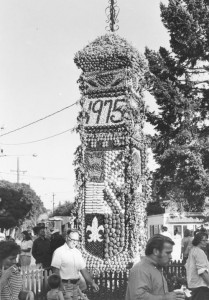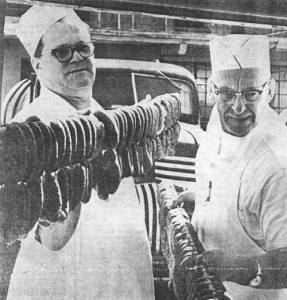OK, we all know if you subtract 1966 from 2015,
you get 49. So why, some ask, is this the 50th
celebration of Oktoberfest? Well, this isn’t a birthday.
The first festival was “1” and if you count you’ll
find this is the 50th time Mount Angel has
held an Oktoberfest celebration.
Oktoberfest in September?
Even in Munich, Germany, the bulk of the
Oktoberfest festivals are in September.
Oktoberfest is a generic words meaning,
“harvest celebration.” Most fall festivals
happen at the end of the harvest. It’s a
time to celebrate the year’s hard work
and the bounty. In Mount Angel,
Oktoberfest always starts the second
Thursday after Labor Day – about when
the hop harvest is in.
Editor’s Note: This is the first of two stories on the 50th celebration of Mount Angel’s Oktoberfest. The next story will appear Sept. 15. This year’s Oktoberfest is Sept. 17-20.
By Kristine Thomas
For the 32nd celebration of Mount Angel’s Oktoberfest, Connie Lauzon and Mary Grant did some digging to discover the festival’s history.
Gathering newspaper clippings and interviewing past and present board members, Grant and Lauzon created a program called, “Oktoberfest, This is Your Life. Prosit!”
The 22-page document they wrote had interviews from Agnes and Virgil Diehl, Jim Unger and Tom Ewing.
Sitting on her couch in her Mount Angel home, Lauzon recently shared old photographs and the write up.
One quote from Grant summarized Oktoberfest’s history.
“Sometimes history is clouded by our memories,” Grant said. “There are often times many versions of the same story. The real consistent element in this story is how true the festival has remained to the vision of its founders.”
Jim Unger told the two that the important element of the festival was keeping it a nonprofit. Since the festival began in 1966, it has raised $3 million for local nonprofits and has helped the library, fire department and high school as well as helping build the willage bandstand and the Festhalle. That figure doesn’t include the money raised by nonprofits selling food in the Alpine chalets.
As for how the idea for the first festival in September 1966 began, well, Lauzon and Grant learned 32 years ago, it all depends on who they asked.

Unger, who was the president of the Mount Angel Chamber of Commerce in 1966, told the women he had never heard of the word “Oktoberfest” until someone came to a meeting to talk about having a harvest festival.
Virgil Diehl told Lauzon it all started with Sam Bates.
“I remember, we used to go to his furniture store quite often and he always started talking about this festival,” Virgil Diehl said.
Agnes Diehl shared they wanted to create a festival where a “family could go and not have to have their hands in their pockets all the time.”
She remembers a group of people went to lunch at Evergreen Golf Club where they met Paul DeShaw, who offered his ideas.
There is the version it was born at Evergreen, Lauzon wrote.
“Sam Bates noted that a Salem golfer suggested that an Oktoberfest theme would be good for Mount Angel because of the German-Swiss background of the town.”
Tom Ewing told Lauzon he had the secret to “exactly how the festival started, told to me by my farther who had spent some time in the service in Germany and had recently retired from the service. It seems that he attended a chamber of commerce meeting as they were discussing what they might do for a festival, since the other festivals had died out. My father, Thomas P. Ewing, was sitting next to Paul DeShaw and leaned over and whispered in his ear, ‘Why don’t they have an Oktoberfest like they have in Munich, Germany?’ and Paul DeShaw took that idea and ran with it and that’s how Oktoberfest started in Mount Angel.”
The Mount Angel community was founded by German pioneers in 1867, and since the surrounding area resembles rural Bavaria, organizers thought the Oktoberfest would be a natural fit.
To learn more about hosting an Oktoberfest, several people visited Leavenworth, Wash. And to promote the event, they took a float to nearby festivals.
There also is some question about how much money the Mount Angel Chamber of Commerce loaned the Oktoberfest committee – some say it was $100 and some say $400.One thing that has remained constant, for 50 celebrations a chamber member has always been a part of the board of directors.
The first year there wasn’t an Oktoberfest board or president or bylaws. The members of the committee in 1966 were Harold Bourbonnais, Leonard Butsch, Don Schmidt, Paul DeShaw, Ron Hannon, Dick Zeis, Virgil Diehl, Sam Bates, Jim Unger, Willie Verboort, Francis Schmidt and Ed Jenck.
The first Mount Angel Oktoberfest in 1966 was held on the corner of Main and Palmer streets, with the biergarten in a tent borrowed from U.S. Bank. That first year the dance floor was constructed the second day of the festival. Organizers hoped for 8,000 people. Mount Angel had about 1,700 residents; Oktoberfest drew about 39,000 attendees. With no room in the cash register, “money was jammed into paper bags.”
At the first celebration, there were seven booths, a German band concert by local high schools, Bavarian dancers, auto and bicycle races, a ball game and a fireman’s waterball contest. The Catholic Daughters held German dinners at the old St. Mary’s Grade School. They prepared dinner for 100 people and 1,200 attended.

“They did a lot of scurrying around local towns to find more sausages and what went with to meet the unexpected demand,” according to Lauzon and Grant’s research.
All in all, tha first year, there was a lot of scurrying to make things work.
By the second year, the organizational plans began to take place.
At the second festival in 1967, the Catholic Daughters joined the Seminary Mother’s Club to host the German dinners at St. Mary’s School. On the menu was sauerkraut, Oktoberfest wurst, assorted breads and cheeses, mashed potatoes, green beans with mushrooms, applesauce and homemade pies. Prices were 75 for kids and $1.50 for adults. In 1967, the festival grew to 20 booths and had a teenage dance, scenes from the from the opera “Carmen,” 6,000 pounds of sausage and 5,000 gallons of beer.
Although written in 1967 in The Statesman’s Journal “Good Monday Morning” column, the words still apply today.
“We did a stint of walking Mt. Angel’s Oktoberfest, though, and are now convinced the entire event, besides being a carload of fun, is a direct plot against our diet. We inhaled enough sausages and luscious unspellables (sic) to feed an army. Our won’t power weakened every time we passed a booth. One thing is sure – we never saw more happy, friendly faces in one place.”
Another writer for The Statesman wrote, “It had the smell of sausage and strudel. It had the sounds of polka and yodel. It had edelweiss and a harvest moon. It had the blessing of the archbishop and the weatherman. It had the kiss of hops. Hundreds of people ebbed and flowed through booth bedecked, blocked-off downtown streets, eating, drinking, listening, singing and enjoying.”
The festival went through some rowdy times when beer was sold in buckets and stickers were popular. An example of the beer stickers is “Blitz Me” along with meat stickers reading “prime choice.”
In 1974, three women were elected to the Oktoberfest board for the first time. They were Henrietta Saalfeld, Jeanne Hannon and Joyce Lindsay.
Mary Grant has been the festival’s only woman president.
Mt. Angel resident Willie Verboort remembers when Mt. Angel had a Dairy Day and a Flax Festival.
“Where the idea for the Oktoberfest came, well, your guess is as good as mine,” he said. “I remember it was Paul DeShaw and Dick Zeis talking about starting the festival and how some others suggested the setting and the hops in the valley reminded them of Germany.”
Verboort attended his first festival when he was 21 years old and hasn’t missed one since. He served on the board for 14 years, including as president.
He remembers food booths running out of food during the first festival, stickers lining sidewalks and the rainy festivals.
In 1975, Mt. Angel’s Oktoberfest was 10 years old and Munich’s was 159. Mt. Angel’s population was listed at 2,500. That year, Verboort told the Capital Journal that “700 kegs were sold.”
“We used to judge how successful a festival was by how many kegs of beer were tapped,” he said.
In 1976, Verboort reported to The Statesman Journal that Oktoberfest had given away $92,000 to organizations in the last eight years.
As cultural attitudes shifted toward drinking, Oktoberfest’s board of directors also realized the need to change.
Jerry and Connie Lauzon moved to Mount Angel in 1989. Jerry was the director of public relations for 20 years. While enchanted with Mt. Angel and the festival, he immediately realized the festival’s rowdy reputation – with the large consumption of beer and the stickers – were “vexing problems” he was determined to solve.
“I didn’t think it was fun or part of our Christian heritage to have some of the disgusting behaviors that were taking place,” he said.
Jerry knew the sticker situation was getting out of hand when he saw young kids putting stickers on one another and how the stickers seemed to carpet the sidewalks.
The icing on the cake was when he and Connie were dressed up in their Bavarian attire and a man had the audacity to slap a sticker on Connie’s chest.
“I saw that as an inappropriate act,” Jerry said.
There were fights in the biergarten because a boyfriend was often offended when another man slapped a sticker on his girlfriend.
Jerry was one of the directors who was determined to change the festival from a rowdy beer party to a family friendly festival.
“There was a time when we had 60 to 70 DUII in a four day period,” Jerry said.
He began working with others and the OLCC to make changes on how beer could be sold – no longer in buckets.
“I believe beer is a gift of God and to see it being consumed this way was not right,” he said. “It was making a mockery out of such a beautiful gift.”
Connie said from her husband’s years in the military, he seemed to relish the tough situations. The worst it was, the more he was challenged to find a solution and make it better, she added.
“Oktoberfest is much better than we found it because of some of the changes he helped to implement,” she said.
It was at the 25th celebration of Oktoberfest that Mary Grant asked Nann Fleck to teach the local children the Maypole dance.
“Once we started with one dance, we kept building the tradition of dancing from there,” she said.
The dancing was one way to change the image of Mt. Angel’s festival from being a rowdy party with beer and meat stickers to a family friendly event with children and adults dressed in German attire.
“I remember when there were meat stickers reading “fresh choice, prime cut or Blitz me,” Fleck said. “The stickers were everywhere from street signs to sidewalks.”
She’s proud of how hard many people have worked to make the festival what it is today.
“There is happy music, great dancing, good food and beautiful weather,” Fleck said. “It’s a place to bring your family.”
From a tent with sawdust on the floor to the new Festhalle, Verboort is proud of how Oktoberfest has grown and changed with the times.
Verboort said if someone had told him Oktoberfest would last 50 years, he wouldn’t have believed them.
“There aren’t many that started 50 years ago that are still going strong like Oktoberfest,” he said. “We never imagined Oktoberfest would be this successful.”